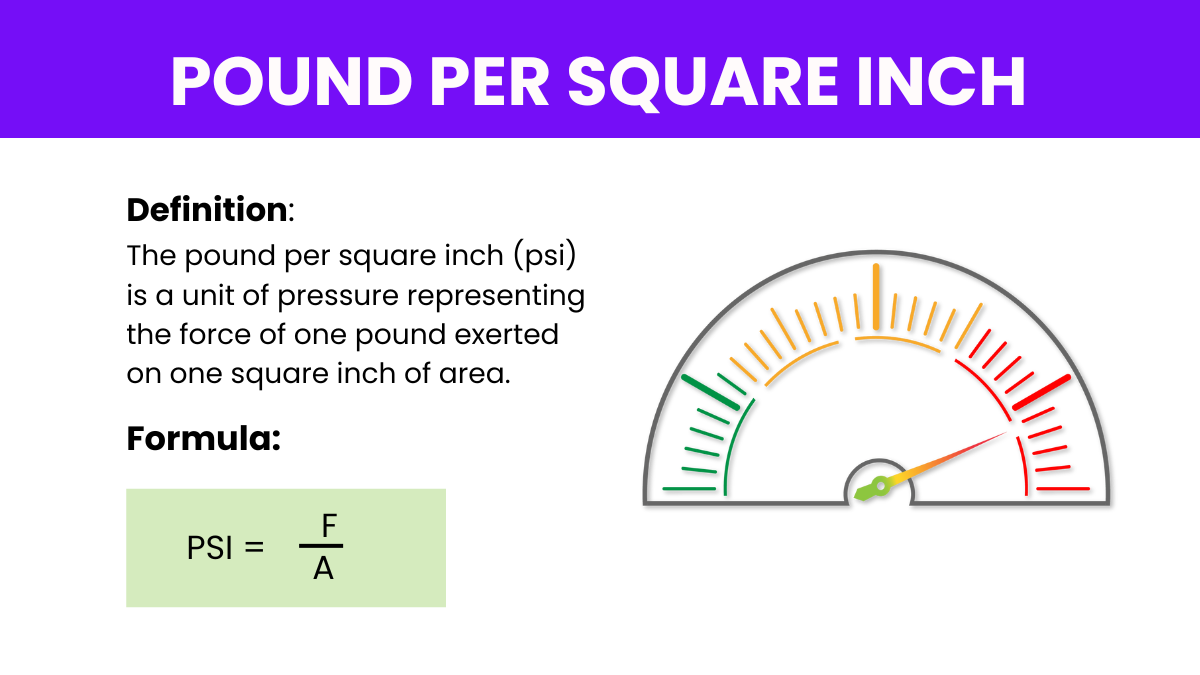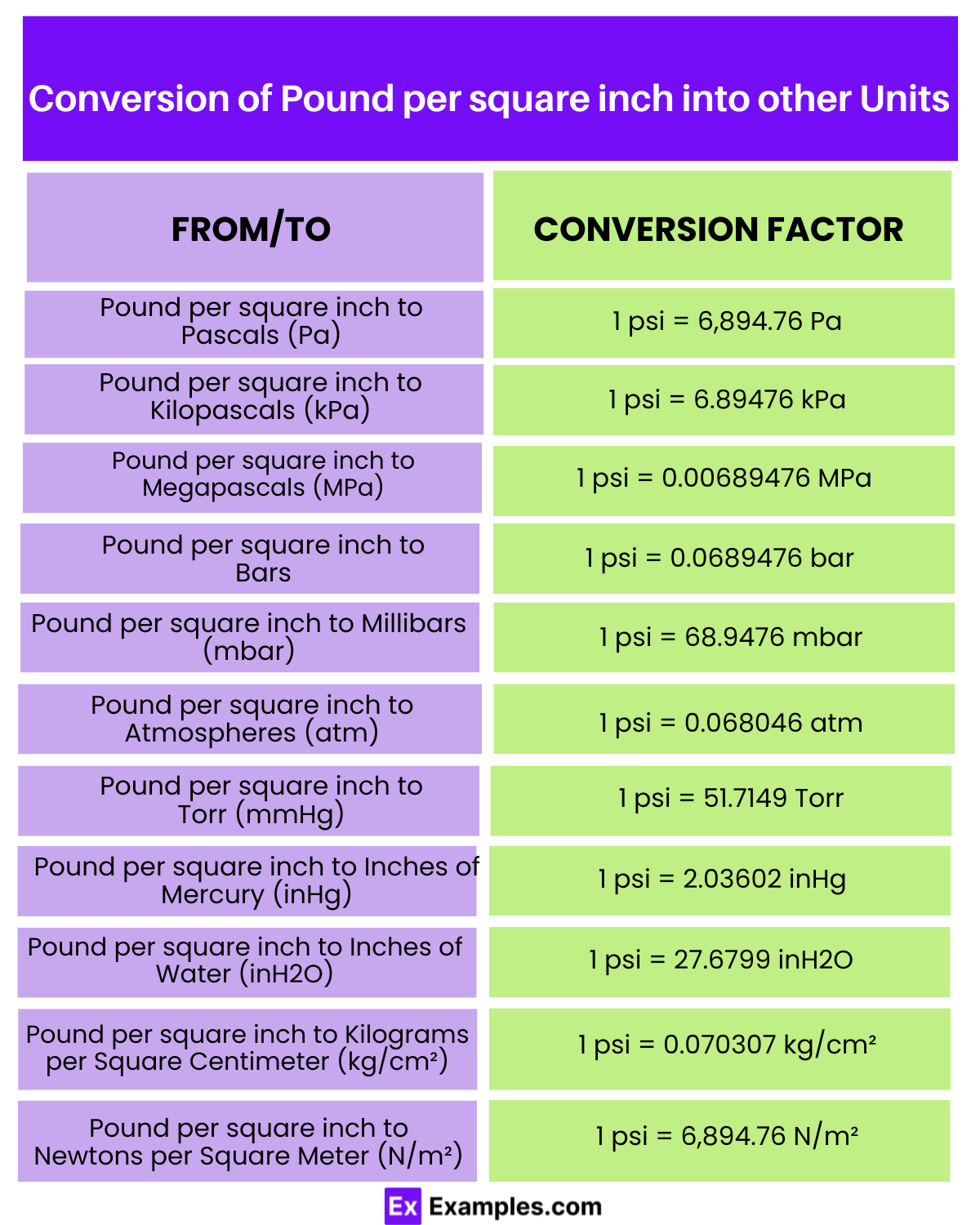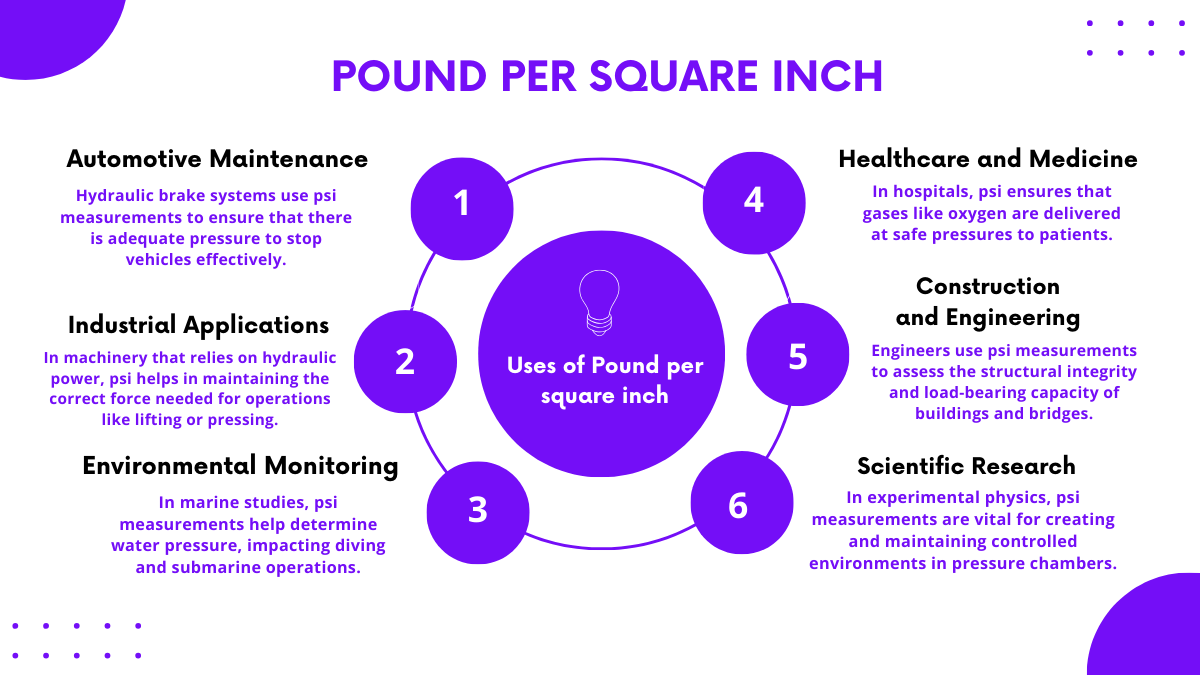What is the equivalent of 20 PSI in Pascals?
137895.5 Pa
144000 Pa
68947.6 Pa
20000 Pa


In Physics Pressure is the force applied perpendicular to the surface of an object per unit area, commonly measured in various units including pascals (Pa), Bars, and pounds per square inch (psi). One bar is roughly equal to the atmospheric pressure at sea level and is approximately equal to 100,000 pascals. The pascal, a unit derived from the metric system, represents one newton per square meter. The pound per square inch (psi) is a traditional Unit of pressure, widely used in the United States, indicating one pound of force applied to an area of one square inch. Understanding these units and their conversions is essential for fields such as physics, engineering, and various applied sciences.
PSI = F/A,
Where:
F is the force applied in pounds,
A is the area over which the force is distributed in square inches.
Head pressure, often measured in pounds per square inch (psi), refers to the pressure exerted by a fluid column due to the force of gravity. It is a crucial concept in fluid dynamics, particularly in plumbing, hydraulics, and civil engineering. The formula for calculating head pressure in psi is:
Head Pressure (psi) = Height of the Fluid Column (ft)×Density of the Fluid (lb/ft3)×Gravity (ft/s2)/144
This formula accounts for the height of the fluid column, the density of the fluid, and the acceleration due to gravity, divided by 144 to convert from square feet to square inches, as there are 144 square inches in a square foot. This conversion is necessary because psi measures the force (in pounds) applied over an area of one square inch. The result gives the pressure at the bottom of the fluid column solely due to its elevation.
Suppose we want to determine the head pressure at the bottom of a water tower that is 50 feet tall. The density of water is approximately 62.4 pounds per cubic foot, and the acceleration due to gravity is about 32.2 feet per second squared.
Formula:
Head Pressure (psi) = Height of the Fluid Column (ft)×Density of the Fluid (lb/ft3)×Gravity (ft/s2)/144
Head Pressure (psi) = 50×62.4×32.2/144
Let’s compute this to find out the head pressure in psi.
The head pressure at the bottom of a 50-foot tall water column is approximately 697.67 psi. This calculation shows how the height of the water column, combined with the density of water and the force of gravity, contributes to the pressure exerted at the base.
| Prefix | Symbol | Multiplier | Value in Pascals (Pa) |
|---|---|---|---|
| Megapsi | MPsi | 10⁶ | 1 MPsi = 6,894,760,000 Pa |
| Kilopsi | kPsi | 10³ | 1 kPsi = 6,894,760 Pa |
| Hectopsi | hPsi | 10² | 1 hPsi = 689,476 Pa |
| Decapsi | daPsi | 10¹ | 1 daPsi = 68,947.6 Pa |
| Decipsi | dPsi | 10⁻¹ | 1 dPsi = 6,894.76 Pa |
| Centipsi | cPsi | 10⁻² | 1 cPsi = 689.476 Pa |
| Millipsi | mPsi | 10⁻³ | 1 mPsi = 68.9476 Pa |
| Micropsi | μPsi | 10⁻⁶ | 1 μPsi = 0.00689476 Pa |
| Nanopsi | nPsi | 10⁻⁹ | 1 nPsi = 0.00000689476 Pa |
| Picopsi | pPsi | 10⁻¹² | 1 pPsi = 0.00000000689476 Pa |
| Femtopsi | fPsi | 10⁻¹⁵ | 1 fPsi = 0.00000000000689476 Pa |

| From/To | Conversion Factor | Example Conversion from 10 psi |
|---|---|---|
| Pound per square inch to Pascals (Pa) | 1 psi = 6,894.76 Pa | 10 psi = 68,947.6 Pa |
| Pound per square inch to Kilopascals (kPa) | 1 psi = 6.89476 kPa | 10 psi = 68.9476 kPa |
| Pound per square inch to Megapascals (MPa) | 1 psi = 0.00689476 MPa | 10 psi = 0.0689476 MPa |
| Pound per square inch to Bars | 1 psi = 0.0689476 bar | 10 psi = 0.689476 bar |
| Pound per square inch to Millibars (mbar) | 1 psi = 68.9476 mbar | 10 psi = 689.476 mbar |
| Pound per square inch to Atmospheres (atm) | 1 psi = 0.068046 atm | 10 psi = 0.68046 atm |
| Pound per square inch to Torr (mmHg) | 1 psi = 51.7149 Torr | 10 psi = 517.149 Torr |
| Pound per square inch to Inches of Mercury (inHg) | 1 psi = 2.03602 inHg | 10 psi = 20.3602 inHg |
| Pound per square inch to Inches of Water (inH2O) | 1 psi = 27.6799 inH2O | 10 psi = 276.799 inH2O |
| Pound per square inch to Kilograms per Square Centimeter (kg/cm²) | 1 psi = 0.070307 kg/cm² | 10 psi = 0.70307 kg/cm² |
| Pound per square inch to Newtons per Square Meter (N/m²) | 1 psi = 6,894.76 N/m² | 10 psi = 68,947.6 N/m² |
Psi is converted to pascals, the standard SI unit for pressure, reflecting the amount of force exerted per square meter. This conversion is foundational for integrating psi into systems used globally, especially in scientific contexts.
These are larger units derived from pascals, used to express higher pressures. Kilopascals represent thousands of pascals, commonly used in industrial settings, while megapascals denote millions of pascals, suitable for high-pressure applications.
The bar is another unit of pressure, close in magnitude to the atmospheric pressure at sea level. Millibars, being smaller fractions of bars, are particularly utilized in meteorological pressure measurements.
This unit is directly related to the average atmospheric pressure at sea level on Earth. It provides a practical scale for gauging pressures relative to environmental conditions.
This unit is directly related to the average atmospheric pressure at sea level on Earth. It provides a practical scale for gauging pressures relative to environmental conditions.
This unit is directly related to the average atmospheric pressure at sea level on Earth. It provides a practical scale for gauging pressures relative to environmental conditions.
Both units are historically derived from the use of mercury in barometers. Torr is closely related to millimeters of mercury, often used in vacuum measurements, while inches of mercury remain common in aviation and meteorology.
To convert pounds per square inch (psi) to inches of mercury (inHg), you can use a specific conversion factor. Generally, the pressure in psi is multiplied by a factor to obtain the equivalent pressure in inches of mercury.
This unit measures the pressure exerted by a column of water and is frequently used in applications involving water pressure, such as plumbing and HVAC systems.
These conversions are critical in engineering and materials science, where pressures need to be understood in terms of weight force distributed over area or as a direct measurement of force per unit area.
These conversions are critical in engineering and materials science, where pressures need to be understood in terms of weight force distributed over area or as a direct measurement of force per unit area.

Weather Forecasting: Meteorologists use psi when measuring atmospheric pressure, which is key to predicting weather patterns and storm developments.
Oxygen Tanks and Respirators: Psi helps monitor and regulate the pressure in medical oxygen tanks and respiratory therapy equipment, ensuring they deliver life-sustaining air at safe pressures.
Oxygen Tanks and Respirators: Psi helps monitor and regulate the pressure in medical oxygen tanks and respiratory therapy equipment, ensuring they deliver life-sustaining air at safe pressures.
Text prompt
Add Tone
10 Examples of Public speaking
20 Examples of Gas lighting
What is the equivalent of 20 PSI in Pascals?
137895.5 Pa
144000 Pa
68947.6 Pa
20000 Pa
If a tire is inflated to 20 PSI, what is the pressure in atmospheres?
1.36 atm
0.3 atm
0.56 atm
1.02 atm
Which of the following pressures is closest to 20 PSI?
250 kPa
100 kPa
138 kPa
175 kPa
A pressure gauge reads 20 PSI. What is this pressure in bar?
1.36 bar
2.75 bar
1.15 bar
3.02 bar
Convert 20 PSI to mmHg.
1034 mmHg
1550 mmHg
1420 mmHg
1200 mmHg
What is the equivalent of 20 PSI in inches of mercury (inHg)?
59.5 inHg
42.8 inH
15.6 inHg
41.2 inHg
If a balloon is inflated to 20 PSI, what is its pressure in kilopascals (kPa)?
145 kPa
100 kPa
138 kPa
200 kPa
A scuba tank has a pressure of 20 PSI. Convert this pressure to Torr.
1034 Torr
1220 Torr
1430 Torr
1550 Torr
The pressure inside a container is measured as 20 PSI. What is this pressure in MPa?
0.2 MPa
1.38 MPa
0.138 MPa
2.0 MPa
What is the pressure in PSI if the pressure is 1.38 bar?
25 PSI
20 PSI
15 PSI
10 PSI
Before you leave, take our quick quiz to enhance your learning!

